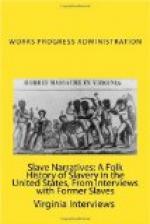They slept in the open plains at night. They had good clothes. They would ride two or three weeks and couldn’t get a switch. Finally in about June or July they would get into Kansas City. The white masters were there waiting and bought food and supplies to take back home. They would have started another troop of cowboys with cattle about June and meet them in Kansas City just before Christmas. Jack liked this life except it was a hard life in bad weather. They had a good living and the Masters made “big money.” Jack said he always had his own money then. His people are scattered around Waco now, “the Boyd negroes.” He hasn’t been back since he came to Arkansas when he was about eighteen. He married here and had “raised” a big family. The plains were full of rattle snakes, rabbits, wild cats and lots of other wild animals. They never started out with less than 400 head of cattle. They picked cattle that would travel about together. It would all be grown or about the same age. The worst thing they had to contend with was a lack of water. They had to carry water along and catch rainwater and hunt places to water the cattle. His father’s and grandfather’s masters names were Gillis, Hawkins, and Sam Boyd. They were the three who came to Texas and located the ranch at Waco. Jack thinks they have been dead a long time but they have heirs around Waco now. Jack Boyd left Waco in 1881.
Circumstances Of Interview
State—Arkansas
Name of worker—Bernice Bowden
ADDEESS—1006 Oak Street, Pine Bluff, Arkansas
Date—November 2, 1938
Subject—Ex-slaves
1. Name and address of informant—Mal Boyd, son of slaves
2. Date and time of interview—November 1, 1938, 9:45 a.m.




